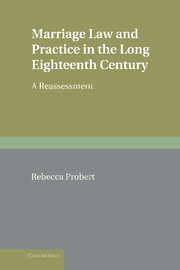Book contents
- Frontmatter
- Contents
- Preface
- 1 Introduction
- 2 The misunderstood contract per verba de praesenti
- 3 The myths of ‘informal’ and ‘common-law’ marriage
- 4 The little-considered marriage practices of non-Anglicans
- 5 The unacknowledged regularity of clandestine marriages
- 6 The eventual passage and actual terms of the 1753 Act
- 7 The unappreciated success of the 1753 Act
- 8 The unexplored judicial interpretation of the 1753 Act
- 9 The overlooked response of non-Anglicans
- 10 Conclusion
- Index
- References
1 - Introduction
Published online by Cambridge University Press: 10 February 2010
- Frontmatter
- Contents
- Preface
- 1 Introduction
- 2 The misunderstood contract per verba de praesenti
- 3 The myths of ‘informal’ and ‘common-law’ marriage
- 4 The little-considered marriage practices of non-Anglicans
- 5 The unacknowledged regularity of clandestine marriages
- 6 The eventual passage and actual terms of the 1753 Act
- 7 The unappreciated success of the 1753 Act
- 8 The unexplored judicial interpretation of the 1753 Act
- 9 The overlooked response of non-Anglicans
- 10 Conclusion
- Index
- References
Summary
It is a scene we are all familiar with: another country church; another bride in incongruously virginal white walks up the aisle, to be given away by a father under whose roof she has not resided for over a decade. The minister asks whether there are any impediments to their union, and members of the congregation look round furtively, perhaps half hoping that an unknown previous spouse will stand up and object. The parties exchange their vows and are declared to be husband and wife.
Many of the components of the supposedly ‘traditional’ wedding – the diamond engagement ring, the white dress, the morning suits, the late-afternoon ceremony followed by dinner and dancing – are innovations of the nineteenth and twentieth centuries. But celebration in church can trace a longer pedigree, and the scene above would have been recognisable to our forbears. While the words of the marriage service have been periodically updated, all the fundamentals currently required by law for a marriage according to the rites of the Church of England – banns or licence, celebration in church, and registration – were in place by the mid-sixteenth century. Today, a Church of England wedding is merely one of a number of permissible routes to legal marriage and only a minority of couples choose to marry in this way.
- Type
- Chapter
- Information
- Marriage Law and Practice in the Long Eighteenth CenturyA Reassessment, pp. 1 - 20Publisher: Cambridge University PressPrint publication year: 2009



